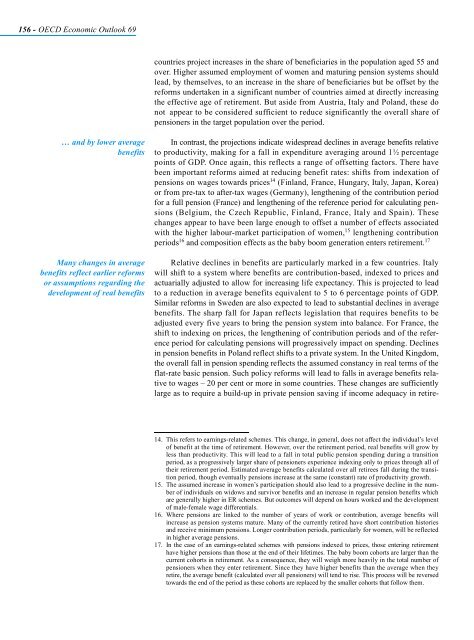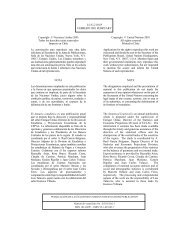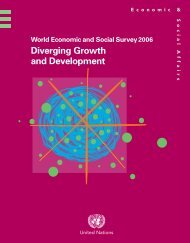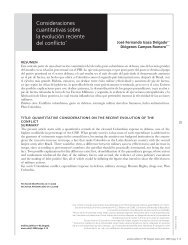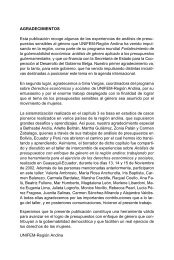OECD Economic Outlook 69 - Biblioteca Hegoa
OECD Economic Outlook 69 - Biblioteca Hegoa
OECD Economic Outlook 69 - Biblioteca Hegoa
Create successful ePaper yourself
Turn your PDF publications into a flip-book with our unique Google optimized e-Paper software.
156 - <strong>OECD</strong> <strong>Economic</strong> <strong>Outlook</strong> <strong>69</strong><br />
… and by lower average<br />
benefits<br />
Many changes in average<br />
benefits reflect earlier reforms<br />
or assumptions regarding the<br />
development of real benefits<br />
countries project increases in the share of beneficiaries in the population aged 55 and<br />
over. Higher assumed employment of women and maturing pension systems should<br />
lead, by themselves, to an increase in the share of beneficiaries but be offset by the<br />
reforms undertaken in a significant number of countries aimed at directly increasing<br />
the effective age of retirement. But aside from Austria, Italy and Poland, these do<br />
not appear to be considered sufficient to reduce significantly the overall share of<br />
pensioners in the target population over the period.<br />
In contrast, the projections indicate widespread declines in average benefits relative<br />
to productivity, making for a fall in expenditure averaging around 1½ percentage<br />
points of GDP. Once again, this reflects a range of offsetting factors. There have<br />
been important reforms aimed at reducing benefit rates: shifts from indexation of<br />
pensions on wages towards prices 14 (Finland, France, Hungary, Italy, Japan, Korea)<br />
or from pre-tax to after-tax wages (Germany), lengthening of the contribution period<br />
for a full pension (France) and lengthening of the reference period for calculating pensions<br />
(Belgium, the Czech Republic, Finland, France, Italy and Spain). These<br />
changes appear to have been large enough to offset a number of effects associated<br />
with the higher labour-market participation of women, 15 lengthening contribution<br />
periods 16 and composition effects as the baby boom generation enters retirement. 17<br />
Relative declines in benefits are particularly marked in a few countries. Italy<br />
will shift to a system where benefits are contribution-based, indexed to prices and<br />
actuarially adjusted to allow for increasing life expectancy. This is projected to lead<br />
to a reduction in average benefits equivalent to 5 to 6 percentage points of GDP.<br />
Similar reforms in Sweden are also expected to lead to substantial declines in average<br />
benefits. The sharp fall for Japan reflects legislation that requires benefits to be<br />
adjusted every five years to bring the pension system into balance. For France, the<br />
shift to indexing on prices, the lengthening of contribution periods and of the reference<br />
period for calculating pensions will progressively impact on spending. Declines<br />
in pension benefits in Poland reflect shifts to a private system. In the United Kingdom,<br />
the overall fall in pension spending reflects the assumed constancy in real terms of the<br />
flat-rate basic pension. Such policy reforms will lead to falls in average benefits relative<br />
to wages – 20 per cent or more in some countries. These changes are sufficiently<br />
large as to require a build-up in private pension saving if income adequacy in retire-<br />
14. This refers to earnings-related schemes. This change, in general, does not affect the individual’s level<br />
of benefit at the time of retirement. However, over the retirement period, real benefits will grow by<br />
less than productivity. This will lead to a fall in total public pension spending during a transition<br />
period, as a progressively larger share of pensioners experience indexing only to prices through all of<br />
their retirement period. Estimated average benefits calculated over all retirees fall during the transition<br />
period, though eventually pensions increase at the same (constant) rate of productivity growth.<br />
15. The assumed increase in women’s participation should also lead to a progressive decline in the number<br />
of individuals on widows and survivor benefits and an increase in regular pension benefits which<br />
are generally higher in ER schemes. But outcomes will depend on hours worked and the development<br />
of male-female wage differentials.<br />
16. Where pensions are linked to the number of years of work or contribution, average benefits will<br />
increase as pension systems mature. Many of the currently retired have short contribution histories<br />
and receive minimum pensions. Longer contribution periods, particularly for women, will be reflected<br />
in higher average pensions.<br />
17. In the case of an earnings-related schemes with pensions indexed to prices, those entering retirement<br />
have higher pensions than those at the end of their lifetimes. The baby boom cohorts are larger than the<br />
current cohorts in retirement. As a consequence, they will weigh more heavily in the total number of<br />
pensioners when they enter retirement. Since they have higher benefits than the average when they<br />
retire, the average benefit (calculated over all pensioners) will tend to rise. This process will be reversed<br />
towards the end of the period as these cohorts are replaced by the smaller cohorts that follow them.


